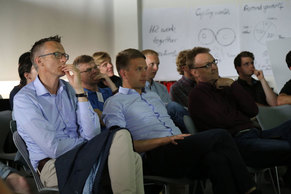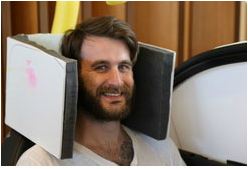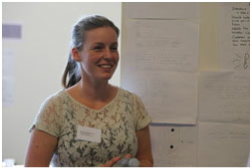From Shanghai to Struer
Date: 15-07-2015
By Asmus S. Jørgensen Shanghai is about 2400 times bigger than Struer, a small Danish city in the north-western part of the country. Nevertheless, both cities have framed the international summer camp “The Innovation Camp”.
In 2012 and 2013 The Innovation Camp powered by Bang & Olufsen was facilitated in China at Shanghai Jiao Tong University. In 2014 the camp paused before it in 2015 returned to Bang & Olufsen in Struer, Denmark. Andrejs Zinkins from Latvia participated in The Innovation Camp in 2013 in Shanghai. Two years later he still remembers the camp vividly. “The Innovation Camp in Shanghai was a great experience. It was an incredible boost for me and it gave me a lot of motivation for the future,” Andrejs Zinkins says on a Skype connection from Poland. Today Andrejs Zinkins is 18 years old. At the time he went to Shanghai with the camp he was 16 years old and lived at the boarding school in Struer studying at the local high school. Spending three weeks in Shanghai at the age of 16 was a big experience and together with students from universities across the world he invented “BeoBag”. A fashionable handbag embedded with a speaker for on-the-go sound. “In the beginning of the camp we conducted field research and interviewed people in Shanghai’s business district. We observed what people were doing and were struck by the numbers of business persons carrying handbags. That inspired us to come up with the “BeoBag” so you always have access to music with high quality sound,” Andrejs Zinkins explains and continues: “We put a lot of work into the development of that bag. At the final presentation in the end of the camp we showed a prototype of the bag and a video with a scenario of how the bag could be used in daily life.” COO: In need of innovative ideas The COO of Bang & Olufsen, Stefan Persson, thinks that The Innovation Camp is a big asset for the Danish company. “It helps us to take the next step in terms of innovation. You get very fast into situations where you are stuck and you are more or less always moving in the same direction, so with a lot of new energy and ideas we can come up with new and more innovative products,” Stefan Persson says and adds: “I still remember when I was a student and you don’t really understand what’s happening out in the real world. At The Innovation Camp they get a sense of what is happening here. They get a sense of what is possible or not possible to do.” At this year’s camp one of the 40 participants is Nicole Strelcheva who studies architecture at The Royal Danish Academy of Fine Arts, School of Architecture. Being at the camp she is happy that she was selected by her tutor to apply for a spot at The Innovation Camp in Struer. “I expected it to be three interesting weeks, both professionally and social, but it has been much more than I had expected. It is very educating; beside a lot of group work, where we get the chance to work with people from other industries, we also have lectures with inspiring persons, “ Nicole Strelcheva says. Even though Struer is a small city with a population of 10.000 it’s not hard to have fun when you are a group of 40 young students. “I wish I could be at the camp again, but that’s not possible. The rules say that you can only participate once. I’m just glad that I joined the camp in 2013 and made so many great friends and connections.” Andrejs Zinkins says. |
|
Stefan Persson (COO), Tue Mantoni (CEO)
|
CEO: We’re spotting the best talents
Date: 14-07-2015
By Asmus S. Jørgensen For the CEO of Bang & Olufsen, Tue Mantoni, The Innovation Camp is an opportunity to meet some talented students from all across the globe and be inspired by the way the young students perceive the world.
“Fundamentally, you should have the mindset that the best talent doesn’t work for you, but is out there somewhere and by working with really innovative people, attracting talent around the world, you can generate ideas and challenge yourself in your own organisation,” Tue Mantoni says. On Wednesday 8th of July he visited The Innovation Camp 2015 to see the students' midway presentations of their work at the camp, which lasts for three weeks. Tue Mantoni was pleased with what he saw and is confident that the 40 students and Bang & Olufsen will gain a lot from The Innovation Camp. “The students meet likeminded people who are some of the best students in the world within architecture, engineering, software, design etc. Hopefully the students also have a lot of fun. In addition to that they get to test their ideas and creativity in a real life setting where we have people who are used to take ideas from the idea phase to real products”. “Sometimes we get concrete products out of it, sometimes we get inspiration, and sometimes we just discover new trends that for sure will pave the way for us in the future, Tue Mantoni says. The CEO doesn’t think that people should be afraid of sharing their good ideas. He encourages the students to be open-minded and learn as much as possible from the Danish company based in Struer. “I think in this world when you have great ideas you should share them and receive feedback. That’s how we operate now and probably even more in the future. Having an idea is one thing; another thing is making it happen. Thinking about how you can turn ideas into real products, real services and real experiences for the consumers." “If you are a person that have a lot of good ideas, the real challenge will be how to translate those ideas into real life situations, products and services and that’s what Bang & Olufsen can teach you." Mass production of ideas
|
|
Date: 03-07-2015
By Asmus S. Jørgensen |
|
Think out of the box. Combine existing devices in a new way or invent a brand-new product. The hardest part of being innovative is getting the right idea many people would claim. At The Innovation Camp hosted by Bang & Olufsen 40 students from various countries and with different professional backgrounds learn how to think innovative in a real-time experience.
“The first days are all about getting ideas. Quantity, quantity, quantity. There are no wrong or bad ideas, everything is a good idea to start with,” Christian Josef Thams from Bang & Olufsen explains. He is the facilitator of The Innovation Camp and encourages the students to turn the world upside down while they twist their brains in an attempt to come up with an original idea. One of the students at the camp, which takes place in Struer in Denmark and lasts three weeks, is Michal Galtha from Poland who is doing a master in mechanical engineering at Cracow University of Technology. During the first days of the camp he made a prototype of a power t-shirt together with his team. The t-shirt converts body heat into energy and powers your connected device, for an instance a smartphone. “I think it’s a good idea because in the future there will be more wireless devices,” Michal Galta explains, “wireless devices need batteries and it is always annoying when you are for example on a trip and your phone or laptop runs out of battery.” However, the exact technology to create the t-shirt is yet to be invented. That is not a requirement for the first phase of the camp. For many of the students it was a tough challenge not to be assigned a precise task and then figure out how to solve it. Instead they had a blank piece of paper, some markers and no limits of what to create. “It was actually kind of hard to get into the creative mode when you are not that used to it, but after a while it became easier,” Line Thomassen Buus from Aalborg University in Denmark says. She is studying engineering psychology and worked on a face recognition system, one of the first days of the camp. Several times a day the students were placed in a new group to exchange ideas and develop them. “Switching groups was very helpful for me. It was a good experience because when someone told about his or her idea I was inspired and able to come up with my own, maybe better, idea,” Michal Galtha from Poland says. The hope with the initial, intensive idea process is that it will help the students later on the camp when they are divided into five groups with separate topics. “It’s all about finding interconnections and in the end having five concepts that will be very Bang & Olufsen,” Christian Josef Thams states. What do you mean by very Bang & Olufsen? “To me Bang & Olufsen is products that are durable, well designed and relevant for everyone.” The facilitator of the camp is pleased with the students work the first days of the camp. “What has impressed me the most is their openness to try this out. If you have been a software engineer all your education you have been taught in a very structured manner of working. Coming here and learning about design thinking, which I call structured chaos, and be cool about it is impressive. They have already come up with concepts that are really relevant for us.” |
|
|
Working together across
|
|
Date: 06-07-2015
By Maiken Solnæs |
|
For the 8th time The Innovation Camp hosted by Bang & Olufsen has invited students from all over the world to collaborate across different disciplines and cultural backgrounds in order to develop new pioneering ideas.
By mixing students from different studies and countries, the participants get to explore new kinds of approaches and working processes - something that many of them appreciate. One of them is Laura Ellemark Lange who is studying industrial design at Design School Kolding. “It is very exciting and inspiring to learn about other peoples cultures and see how they react in different situations. And it is not only our way of thinking that differs but also our way to use body language. That is not something that we get to experience everyday,” she explains. During the first week of the camp she has already collaborated with students not only from other countries, but also from other study fields than her own. “This first week has been most about conceptualizing, getting ideas and designing prototypes which I feel is part of my forte, but as soon as we are going to face the constructing phase I think the roles will quickly be switched.” This way of utilizing each one's abilities is a part of the foundation of The Innovation Camp and even though the participants come from different places there is still one thing that they all have in common: “One of the greatest things about the camp is that wherever people come from we are all working to reach the same common goal,” Gong Zheng from China explains. Gong Zheng is studying electronic and computer engineering at Shanghai Jiao Tong University and as most of the students he looks very much forward to learn from others during his three weeks stay in Struer. Meanwhile the students have already been doing a great piece of teamwork Richard Vos, professor at Hanze University Groningen in The Netherlands, is pleased to witness the openness and respect among the students. This year is his 6th time at the camp and his previous experiences tell him that working across cultures and professions can be a tough challenge, but as soon as the students learn to appreciate the differences and see it as an asset instead of a hindrance they often ends up with better solutions than when working independently. An important lesson that they according to him can make use of for the rest of their lives. Sound Trees and Luxury Cars
Date: 15-7-2015
By Shengjun Wang In the beginning of The Innovation Camp, students
were assigned to come up with ideas within several hours and build prototypes
displaying how the Ideas should work. Each of the groups had one specific topic
regarding the business areas were Bang & Olufsen is active in. They were
encouraged to think out of the box and be creative in order to complete the
assignment in such a short time span. The idea behind this
assignment is to perform under stressful circumstances and be persistent in
order to complete the assignment and make sure students recognize the value of good
teamwork.
|









